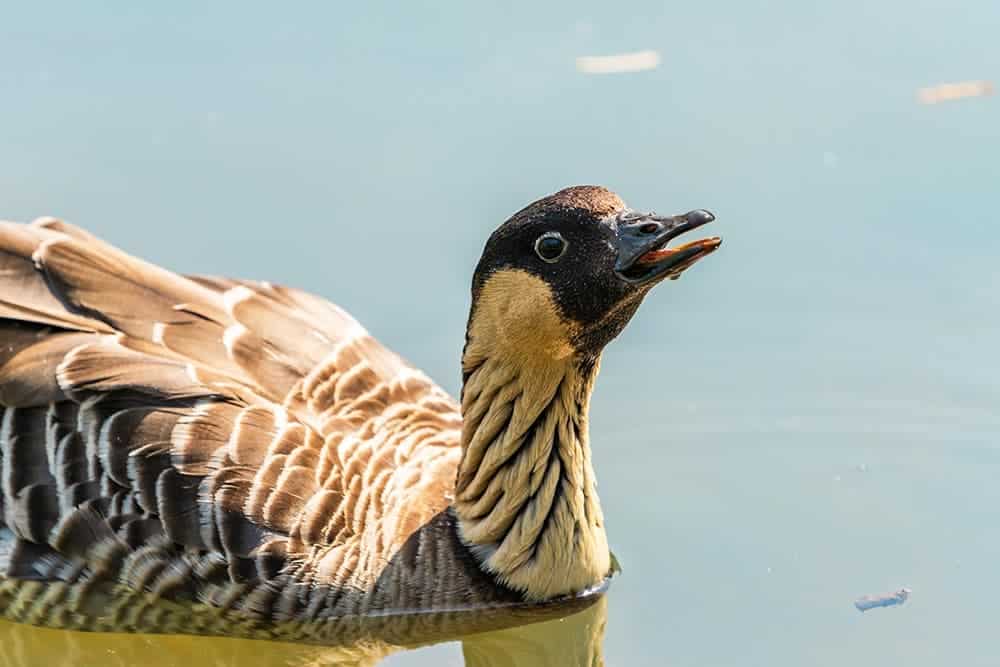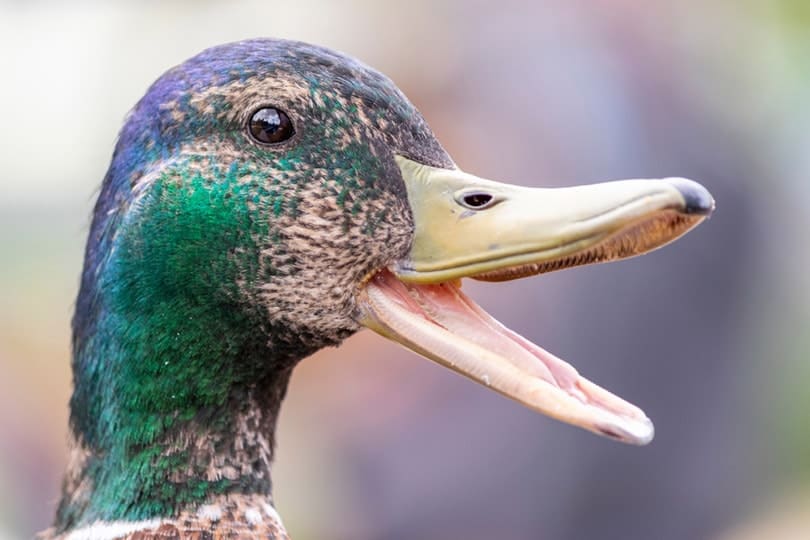If you’ve ever been to a park that has a lake or live near the water, then you’re going to eventually run into ducks. Ducks are also one of the prettiest things you’ll see by the water. However, many people wonder if these omnivores have teeth. The answer is no, not in the traditional sense.
Just like other birds, ducks do not have teeth. So, how do they chew the various nuts, mollusks, insects, grains, foods, seeds, and other foods you see them munching on, on your daily walk around the lake? In this blog, we’ll talk about how ducks eat and even a few other facts about ducks you might not have known.

So, Do Ducks Have Teeth?
The answer, as previously stated, is no, not in the usual sense. They don’t have razor-sharp teeth like a wolf, tiger, shark, or even a human. Instead, their duck bills are serrated, which looks like teeth to people who don’t know much about ducks. So, while they don’t have teeth, they do have help when it comes to eating.
Can Ducks Chew Their Food?
Ducks don’t have teeth, so they can’t chew their food. So, how do they eat? The answer to this question is they just simply swallow their food.
Ducks have adapted to their environment over the years, especially with the sizes and shapes of their bills.
Ducks use their bills to catch their food, then once it’s swallowed, it travels through their gizzard, which grounds up the food before it hits their stomach.
Over time, the ducks adapted to eating smaller prey, such as insects, small fish, snails, slugs, and mussels, as well as seeds and grains. This varied diet keeps the duck from having to chew their food.
While they might not have the sharp teeth that other animals do, their bills structure helps them to easily eat and digest their food.

What Is the Duck Bill Made Up Of?
As previously stated, ducks don’t have teeth, but it’s made up for in their duckbills. Below, we’ll talk about the structure of the duck bill in layman’s terms.
1. Lamellae
The lamellae are just inside the edge of the duck’s bill and are what look like serrated teeth to many people. These lamellae are used to filter things like mud from water. While most dabbing ducks have lamellae, it varies from species to species.
2. Spatulate Shape
The shape of the bill is elongated, flat, and made up of raw bone. The spatulate bill shape is what helps the duck pulverize their food before swallowing. Ducks don’t chew their food, so the bill allows them to get it ready to swallow and digest.
The shape of the bill also varies from one species of duck to the other.
3. Nail
The nail is situated on the upper part of their bill and is a little bump. The ducks use this bump to dig for food through mud and debris. This is how the ducks find worms and other small food. The nail can be used to determine the type of species a duck is on occasion as well, according to the species.
4. Grin Patch
There’s a slightly strange curvature on the duck’s bill on the side of its mouth. We’re not sure what that’s used for, but it has contrasting colors and can make the duck look like it’s smiling, which it might be.
Also, the grin patch isn’t found on all ducks, just a few species.
This is about it for the structure of the duck’s mouth and how they eat their food with no teeth. Next, we’ll move into a few questions we’ve heard people ask over the years about ducks and try to give you some answers.

Duck FAQ’s: Things You Might Want to Know
Do Ducks Bite?
Just as with any other species, if a duck feels threatened or feels that you’re threatening the nest, then they will attack you. Female ducks are more apt to bite you if they feel you’re harming their eggs or ducklings.
The male of the species might attack if they feel you’re a threat to their partner or they believe you’re encroaching on their territory.
Do Duck Bites Hurt?
You would think that since ducks don’t have teeth, getting bitten by one wouldn’t hurt. That’s not true. Even without teeth, a duck bite can be quite painful. However, you shouldn’t have a problem if you know when a duck feels threatened and take proper measures to calm the duck.
What Can You Feed a Duck?
Many duck lovers aren’t sure what type of food they can feed ducks, especially since they don’t have any teeth to speak of. While you can feed the ducks, make sure that the food you give them is cut into manageable, bite-size pieces.
The best foods to feed a duck are peas, birdseed, and small cut vegetables. Feeding them small pieces of food lessens the duck’s chances of becoming choked and being injured.
You need to stay away from feeding your ducks large pieces of food, as well as carbs such as cookies, bread, or popcorn. These foods have no nutritional value and are junk foods, to begin with.
If you’re going to feed the ducks, it’s best to know what’s safe and nutritional for ducks ahead of time. If you’re going to feed the ducks nuts, make sure to grind them up first. Bigger pieces of food and large nuts can easily choke a duck because they are toothless.

Final Thoughts
Ducks are some of the prettiest and most fascinating animals on the planet, in our opinion. In fact, no other species of bird can consume as much food as ducks do, even without having any teeth. Ducks are extremely popular with bird lovers for this very reason.
As for the question of whether ducks have teeth or not, the answer is no. However, that doesn’t stop these colorful birds from eating almost anything they want to eat and enjoying it thoroughly.
Featured Image Credit: Sharon de Groot, Shutterstock
